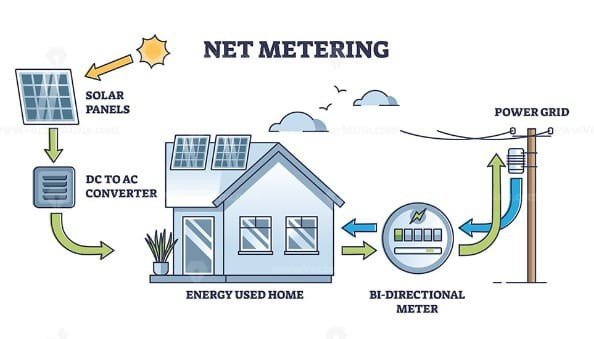Understanding Net Metering in Solar Energy Systems

Net metering is one of the most important concepts in the world of renewable energy, especially solar energy. It allows homeowners and businesses with solar panels to send excess electricity back to the grid and receive credit for it. This simple yet powerful mechanism helps users save on electricity costs, promotes clean energy usage, and reduces the strain on fossil fuel-based power plants.
In this comprehensive guide, we’ll explore what net metering is, how it works, its benefits, real-world examples, challenges, and how you can take advantage of it.
What Is Net Metering?
Net metering (or net energy metering – NEM) is a billing mechanism that allows solar panel owners to feed the surplus electricity they generate back to the power grid. In return, they receive credits on their electricity bill.
Essentially, it allows you to “store” your solar energy or sol celler on the grid when your system produces more than you need and draw from it when you need extra power, such as at night or on cloudy days.
How Net Metering Works
- Solar Generation: During the day, especially around midday, solar panels produce the most electricity—often more than a household or small business consumes.
- Excess Power Sent to Grid: The excess power generated is automatically sent back to the utility grid through a bi-directional meter.
- Credit for Exported Energy: The utility company tracks how much electricity you send back and how much you draw from the grid. You’re billed for the net amount, i.e., the difference between what you used and what you exported.
- Offsetting Future Usage: If you generate more electricity than you use in a month, the surplus credits roll over to the next billing cycle.
Example:
- Your system generates 600 kWh in a month.
- You use only 500 kWh.
- You send 100 kWh to the grid and receive credit.
- Next month, if you use 550 kWh but generate only 450 kWh, your 100 kWh credit offsets the difference.
Types of Net Metering
There are several types of net metering policies depending on your location and your utility provider:
1. True Net Metering (1:1 Credit)
You get a full retail rate credit (same price as you buy electricity for). This is the most favorable option for consumers.
2. Time-of-Use (TOU) Net Metering
Electricity rates vary depending on the time of day. Credits are given based on the time the energy is sent to the grid.
3. Net Billing
Instead of a credit, you get compensated at a predetermined rate (usually lower than retail) for the electricity you send to the grid.
4. Virtual Net Metering
Allows solar energy credits to be shared among multiple users, such as tenants in an apartment complex.
Read Also: Everyday Tech with PCRedCom: Gadgets That Make Life Easier
Benefits of Net Metering
1. Lower Electricity Bills
Net metering reduces your utility bill by crediting you for excess power sent to the grid. Over time, it can significantly reduce or even eliminate your electricity charges.
2. Faster Return on Investment (ROI)
With bill savings and credits, solar panel owners can recover their installation costs faster.
3. Promotes Renewable Energy
Net metering encourages the adoption of solar energy, reducing reliance on fossil fuels and lowering greenhouse gas emissions.
4. Reduces Grid Load
During peak sunlight hours, solar homes send electricity to the grid, helping reduce pressure on power plants.
5. Energy Independence
With net metering and solar, homeowners become less dependent on traditional energy sources and fluctuating prices.
Net Metering Policies by Region
Net metering policies vary widely depending on the country or state.
United States
Many U.S. states have adopted net metering policies, though some are shifting to net billing. States like California (NEM 3.0) are modifying rules to reduce compensation for exported electricity during peak generation times.
India
Net metering is available in many states with generous support from DISCOMs. The Government of India promotes rooftop solar with net metering to achieve its renewable energy goals.
Pakistan
Net metering in Pakistan is regulated by NEPRA. Consumers with solar systems ranging from 1 kW to 1 MW can apply for a net metering license and benefit from energy export credits.
Europe
Countries like Germany, the UK, and Spain offer variations of feed-in tariffs and net metering. The trend is moving toward incentivizing self-consumption.
Key Equipment for Net Metering
To set up a net metering-compatible solar system, you need:
1. Solar Panels
Converts sunlight into electricity.
2. Inverter
Converts direct current (DC) into alternating current (AC) used by home appliances.
3. Bi-directional (Net) Meter
Measures both electricity imported from and exported to the grid.
4. Smart Energy Monitoring System
Tracks production, consumption, and grid usage in real-time. Get complete details about Solee
Financial Impact of Net Metering
Upfront Investment
- Solar system installation can be costly, but with incentives, it becomes manageable.
Payback Period
- Most systems break even in 5–8 years with net metering in place.
Long-Term Savings
- With an average lifespan of 25 years, a solar system can provide 15–20 years of almost free electricity after payback.
Common Myths About Net Metering
❌ Myth 1: You need batteries to use net metering.
Truth: Net metering works without batteries. The grid acts like a virtual battery.
❌ Myth 2: Net metering allows unlimited income from solar.
Truth: Most policies cap the credits to prevent users from becoming full-time energy sellers.
❌ Myth 3: It’s only for large homes or commercial buildings.
Truth: Net metering is available to small home installations too.
Challenges and Limitations
1. Changing Policies
As solar adoption grows, utility companies sometimes reduce credit rates to manage grid load and revenue.
2. Grid Dependency
Net metering doesn’t provide backup power during blackouts unless you have battery storage.
3. Installation Costs
The initial cost of a Solar system is still a hurdle for many users.
4. Administrative Hurdles
Some regions have complex processes for net metering approval, licensing, and metering upgrades.
The Future of Net Metering
As technology and policy evolve, net metering is expected to transition toward:
- Dynamic pricing models
- Increased focus on self-consumption
- Integration with battery storage
- Smarter grid management
- Community/shared solar models
Tips for Maximizing Net Metering Benefits
- Optimize System Size: Size your solar system to match your average consumption.
- Understand Your Tariff Plan: Choose TOU or flat-rate tariffs based on your usage pattern.
- Install a Smart Meter: Helps you track and manage energy usage efficiently.
- Regular Maintenance: Keep your panels clean and your inverter updated.
- Stay Informed: Monitor changes in your local net metering policy.
Conclusion
Net metering is a powerful incentive that makes solar energy even more attractive. By turning your home into a mini power plant, you can lower your electricity bills, contribute to a greener planet, and enjoy long-term energy savings.
Whether you’re a homeowner, business, or policymaker, understanding net metering is crucial to unlocking the full potential of solar energy. As renewable energy adoption continues to rise, net metering will play a central role in reshaping how we produce and consume electricity.
Frequently Asked Questions (FAQs)
1. Is net metering available for all types of solar systems?
Yes, most grid-tied solar systems with inverters and bi-directional meters are eligible.
2. Can I earn money from net metering?
You usually receive bill credits, not direct payments. Excess credits may roll over or expire based on local rules.
3. What happens to credits at the end of the year?
In many cases, unused credits expire annually. Some utilities may offer a small payout or carry credits forward.
4. Do I still need a battery if I have net metering?
No, but having a battery offers backup power during outages and helps store excess solar energy for night use.
5. Can I disconnect from the grid entirely with net metering?
Net metering requires a grid connection. If you want complete independence, you’ll need an off-grid system with storage.





